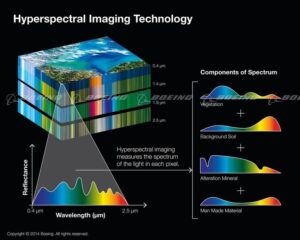NRO awards first commercial contract for hyperspectral imaging from space

WASHINGTON — The National Reconnaissance Office awarded its first commercial hyperspectral imaging study contract to HySpecIQ, a private-equity backed startup based in Washington, D.C.
The NRO described the award, announced on Monday, as the “latest milestone in the agency’s commercial imagery acquisition and integration strategy.”
The contract follows three commercial imagery study awards announced by the NRO in June to BlackSky Global, Maxar Technologies and Planet.
A spokeswoman for the NRO said the agency does not disclose the value of its contract awards.
Pete Muend, director of the NRO Commercial Systems Program Office, said in a statement that HySpecIQ is “developing interesting new hyperspectral imaging capabilities that have the potential to contribute to our current and future overhead architecture.” He said the NRO “plans to take full advantage of diverse phenomenologies available in the commercial market, such as hyperspectral imaging.”
Hyperspectral images are made up of light from hundreds of colors across the electromagnetic spectrum. Since hyperspectral imaging collects many different colors of light, any given object will have a unique signature. This enables users to obtain information about each pixel in an image, with the goal of identifying objects and materials.
The NRO said it will use these and future study contracts to assess domestic commercial satellite imagery providers. The results will help inform the next generation of NRO’s commercial imagery procurements, expected to begin in late 2020.
The NRO calls these “study contracts” because the information it receives from vendors will be used by the agency to examine the companies’ abilities to task, collect process and deliver satellite imagery. “These are major efforts to start working with vendors that traditionally we have not, to figure out how they can deliver product and best meet the requirements,” Troy Meink, director of the NRO’s geospatial intelligence directorate, said in a June interview. “We are trying to understand how we can use their capability. Licensing is always a big deal. That’s part of the study phase. How could we license that data?”
The newly created Commercial Systems Program Office at the NRO will oversee the procurement of imagery.
HySpecIQ’s rough start
HySpecIQ was founded in 2013 and first made news in 2014 when it announced plans to deploy hyperspectral sensors on two Boeing 502 Phoenix small satellites. In early 2015, HySpecIQ obtained a license from the U.S. National Oceanic and Atmospheric Administration to operate its HySpec-1 and HySpec-2 satellites with electro-optical hyperspectral and panchromatic imaging sensors in a sun synchronous low Earth orbit.
But the company canceled the order in 2015 due to a drop in commodity prices and financial setbacks. HySpecIQ said at the time it would be on hiatus until the market improved. Other startups in the hypersectral imaging business also have struggled to commercialize the technology.
Although HySpecIQ experienced a “false start” it now has a plan to develop a constellation as well as data analytic capabilities, said Keith Masback, a strategic consultant to HySpecIQ who was authorized to speak for the company,
Back in 2015, “the time wasn’t right,” Masback told SpaceNews on Monday. The technology wasn’t mature, it was costly and access to launch vehicles was a problem. But the premise that space-based hyperspectral imaging has utility for commercial and government organization has not changed, Masback said. The vision is achievable now “due to everything that has happened in the space market.”
HySpecIQ is working with vendors to figure out the right mix of sensor and bus providers, how they will be integrated and who will launch the satellites, Masback said. “All that is coming together.” In addition, “we are doing studies on commercial use cases and with the support of the NRO we are doing studies on the national security use cases.”
Masback cautioned that the company is being careful to not over promise and under deliver. “We believe within 24 to 36 months we will have two to three satellites on orbit.” The sensors will be tested in various parts of the electromagnetic spectrum on an aircraft in parallel to the integration of the sensors with the satellite platform. That plan is only preliminary, however. “We have a lot of modeling and simulation to do,” he said. “Some of this will be part of the NRO study. We want to deliver an understanding of what different constellations will look like based on how sensors are optimized for which parts of the spectrum,” Masback added. “There’s a lot of variables in the equation.”
Another concern is the data analytics, said Masback. “We are not myopically focused on the space segment . In parallel we’re building the analytics engine that is able to churn out decision-quality information.”
Masback said he believes the NRO selected the company because of its technology and human capital. “We developed technology that will substantially reduce the cost and time to market,” he said. “We red-teamed that independently and we were able to share those results with the NRO.”
Hyperspectral imaging is used commercially in the agriculture, mining, oil and gas, and insurance industries. It also is employed by governments and nongovernmental organizations to monitor disaster areas and organize disaster response. “The commercial use cases tend to overlap with national security,” Masback said.
Robert Cardillo, former director of the National Geospatial Intelligence Agency, told SpaceNews that the NRO study contract is a “good sign that it is taking seriously its responsibility to ensure the government understands the totality of the commercial imagery market as it considers future government architectures.” The U.S. commercial imagery market, which includes a mix of companies flying today and others with plans for tomorrow, he said, “is vibrant and clearly has additional potential to satisfy U.S. government needs.”
from SpaceNews.com https://ift.tt/2mHPgvj
Comments
Post a Comment